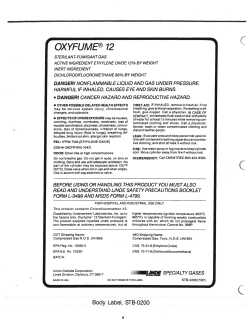
Development of a Germline Transformation System for the Western
Development of a Germline Transformation System for the Western Corn Rootworm, Diabrotica virgifera virgifera Fu-Chyun Chu, Stephanie Gorski, Yasmin J. Cardoza and Marcé D. Lorenzen North Carolina State University Raleigh, North Carolina fchu@ncsu.edu The western corn rootworm (WCR) is a major pest of maize and is notorious for rapidly adapting biochemically, behaviorally and developmentally to a variety of control methods. Despite much effort, the genetic basis of WCR adaptation remains a mystery. Transformation-based applications such as transposon tagging and enhancer trapping have facilitated the genetic dissection of model species such as Drosophila melanogaster. Following this model, we are developing a genome-wide mutagenesis system for use in WCR. However, we must first establish a germline transformation system for use in this beetle. Here we report results from our first sets of experiments. These include: 1) testing marker genes (EGFP and DsRed); 2) testing heterologous promoters (Tc-alpha-Tubulin and Dm-heat-shock-70); and 3) testing transposable elements (piggyBac and Minos). Since our overall goal is to create a jumpstarter mutagenesis system that is analogous to that used in another coleopteran, the red flour beetle, Tribolium castaneum, we are also using the CRISPR/Cas9 system to: 1) create a white-eyed mutant strain; and 2) specifically target transposon insertions to precise genomic locations (i.e. locations analogous to those known to enable efficient piggyBac remobilization in Tribolium). Establishing transgenic technologies in WCR is the first step towards bringing a wide-range of transformationbased tools to bear on understanding WCR biology, which can then be extended to other rootworm species. 260 New DNA-Editing Approaches: Methods, Applications and Policy for Agriculture Unraveling the Unique Mechanism of EthyleneInduced Abscission in Non-Climacteric Sweet Cherry, Prunus avium Benjamin Kilian Washington State University Pullman, Washington kilianbe@gmail.com Sweet cherry, Prunus avium, is a unique non-climacteric member of Rosaceae that comprises some of the classical climacteric species such as apple, pear and peach. Previous phenotypic data established that exogenous ethylene treatment has a genotype-dependent effect on pedicel retention as the fruit nears maturity. This is an intriguing result because sweet cherry is considered non-climacteric and, therefore, does not display positive reinforcement in ethylene production and elevated respiration. This observation prompted our inquiry of what could initiate the response to ethylene of certain genotypes of a non-climacteric fruit in the formation of an abscission zone? Part of the answer at least can be derived from gene-expression studies. I have addressed this question by measuring abscission-zone formation indirectly by pedicel fruit retention force (PFRF) and gathering contemporaneous RNA-Seq profiles to correlate the physiological data. For the experiment, three sweet cherry genotypes were selected which best represented the diversity of responses to ethylene. ‘Chelan’ does not respond to ethylene application. ‘Skeena’ also does not respond to ethylene; however, it forms an abscission zone naturally. ‘Bing’ is the unique genotype that forms an abscission zone in response to ethylene, lowering stem-retention force enough to enable mechanical harvesting. The experiments assessed relative genotypic responses to ethylene in the final phase of fruit maturation prior to harvest. Surgically defined abscission zone tissues from each genotype were collected and used to generate quantitative gene-expression data (RNA-Seq). The sequence data have been de novo assembled into genotype-specific transcriptomes and relative expression for each gene showed the differences among genotypes. With these studies we have identified specific genetic elements specifically in ‘Bing’ that are differentially expressed in response to ethylene. These include transcription factors rapidly responding to the ethylene signal and their potential target sequences, more delayed cell wall-modifying enzymes, and others connected to programmed cell death processes. We are currently validating expression 261 of these genes over multiple seasons and plan on performing subsequent experiments to demonstrate ethylene response. Agricultural labor availability and safety is currently a large problem in the United States in general, and the Pacific Northwest in particular. One solution is the facilitation of mechanical harvest, which would lower cost of production and increase worker safety. Identifying or transferring the required element(s) via classical breeding or through genetic modification into target species has the potential to facilitate more efficient harvesting. My PhD work revolves around the approach that we can predict and/or induce the formation of a pedicel-fruit abscission zone in sweet cherry, a crop with particularly high labor demand and cost. While aimed primarily at sweet cherry, the technology could be applied to mechanically harvesting a wide range of crops. 262 New DNA-Editing Approaches: Methods, Applications and Policy for Agriculture Early Flowering Salvia hispanica (Chia) Composition William Serson1, Paul Armstrong2, Timothy Phillips1 and David Hildebrand1 University of Kentucky Lexington, Kentucky 1 USDA-ARS Grain Marketing and Production Research Center Manhattan, Kansas 2 william.serson@uky.edu A sustainable, affordable source of omega-3 fatty acids has been of high interest to those interested in human and animal nutrition due to known heart-health benefits. Chia is an ancient crop that has experienced an agricultural resurgence in recent decades, though it can only be grown in central latitudes due to its need for short-day flowering. Using EMS and gamma radiation, researchers at the University of Kentucky have developed a long-day flowering mutant which can be grown in the heartland of the United States. While the agronomics continue to be hashed out, we are interested in observing seed composition. If EMS and gamma radiation did not mutagenize genes relevant to seed composition, then we would anticipate no significant changes in seed composition. Five lines with agronomic potential were evaluated for fiber, oil, protein, and fatty-acid content and compared to the parent line, ‘Pinta’. A Dunnett’s test confirmed that there were 3 varieties with significantly higher fiber, one with higher protein, and one with higher 16:0 levels. Some of these changes could be due to mutations of genes that are responsible for helping determine seed composition. However, further trials will be needed to investigate genotype by environment interactions. 263 Effect of Different Gums on the Functional Properties of Soy-Based Nile Tilapia Feed P. Singha and K. Muthukumarappan South Dakota State University, Brookings, South Dakota p.s.technologist@gmail.com Plant-origin polymeric binding agents, cellulosic gum, and starch are often used to improve the cohesiveness of extruded aquafeed. Exopolysaccharide gum such as pullulan and xanthan secreted by microorganisms has unique properties that have been used in food and pharmaceutical products for decades. Isocaloric ingredient blends were formulated for Nile tilapia using a constant level of defatted soybean meal (DFSBM) as a fishmeal replacer and graded levels of five different binders (guar, wheat gluten, xanthan, CMC, and pullulan). Extrusion trials were performed using a single-screw extruder at two levels of screw speed (100 and 150 rpm). To acquire more distinct results for the effect of utilized binders, the extrusion-barrel temperatures, blend-moisture content, die diameter, and screw-compression ratio were kept constant at 100–120–140ºC, 20% db, 3 mm, and 3:1 respectively. A fishmeal-based diet was used as the control diet. Physical properties of the extruded products including expansion ratio, durability, water stability, water solubility, and densities were quantified. It is hypothesized that exopolysaccharide binder can provide similar binding properties in extruded aquafeed formula when compared to conventional binders. 264 New DNA-Editing Approaches: Methods, Applications and Policy for Agriculture Evaluation of Carrot (Daucus carota L.) for Traits Related to Early Seedling Establishment and Canopy Growth at Different Planting Densities Sarah Turner and Philipp W. Simon USDA-ARS, University of Wisconsin Madison, Wisconsin sdturner2@wisc.edu Carrot production is limited by erratic germination, poor seedling growth, and delayed canopy establishment, all of which make weed control a major challenge. Plants with early germination, quick seedling growth, and competitive growth response are one viable option for improving weed management. Preliminary field trials have demonstrated that carrot genotypes have variable germination rates and responses to planting density, ranging from no response to an increase in canopy growth as planting density increases. This project aims to elucidate competitive growth response in diverse carrot-breeding stocks. Four genotypes with small canopy size and four with large canopy size were planted at different densities (30, 60, and 90 plants per meter) using a randomized complete-block design with three replications. Emergence, canopy height, and canopy width were monitored throughout the growing season and postharvest measurements of fresh leaf weight, root weight, and dry leaf weight were taken. Plant height was significantly affected by planting density, genotype, location, and genotype by location interaction. In general, increasing planting density promoted top growth at the expense of root weight, but this response varied by genotype. Current progress will be reported. 265 Targeted Mutation and Precise Genome Editing in Plants with CRISPR/Cas9 System Kabin Xie, Bastian Minkenberg, Xiangling Shen, Qin Wang and Yinong Yang The Pennsylvania State University University Park, Pennsylvania yuy3@psu.edu The bacterial cluster regularly interspaced short palindromic repeats (CRISPR)-associated nuclease (Cas) system has recently emerged as an efficient and versatile tool for genome editing. In this study, we have demonstrated targeted mutation and precise genome editing with CRISPR-Cas9 system in both monocot and dicot plants. The engineered gRNAs were shown to direct the Cas9 nuclease for precise cleavage at the desired genomic sites and introduce specific mutations (insertion or deletion) at a high efficiency by errorprone non-homologous end-joining repairing. In addition, new strategies and tools are being developed for simultaneous mutation of multiple genes, site-directed mutagenesis, site-specific gene integration and precise deletion of chromosomal fragment in plants. To assess potential off-target effects and increase the specificity of CRISPR-Cas9 system, we have performed genome-wide prediction of highly specific gRNA spacer sequences and targetable transcription units in eight model plants and major crops. A bioinformatic database and web tool have been developed to help design highly specific gRNAs and assess their off-target potential. With improved bioinformatic prediction and new experimental strategies, CRISPR-Cas9-mediated genome editing is rapidly becoming a powerful tool for plant functional genomics and genetic improvement of agricultural crops. 266 New DNA-Editing Approaches: Methods, Applications and Policy for Agriculture
© Copyright 2025











